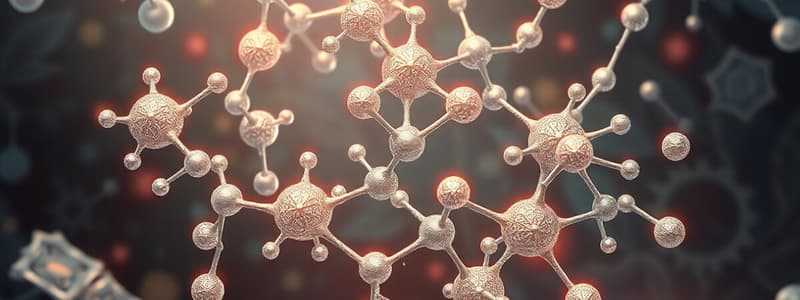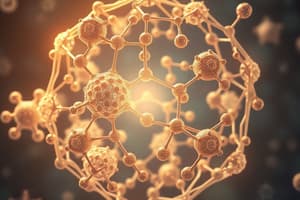Podcast
Questions and Answers
What reaction involves the addition of water to break down molecules?
What reaction involves the addition of water to break down molecules?
- Condensation Reaction
- Oxidation Reaction
- Dehydration Reaction
- Hydrolysis Reaction (correct)
Which type of bond is formed when atoms share pairs of electrons?
Which type of bond is formed when atoms share pairs of electrons?
- Hydrogen Bond
- Ionic Bond
- Metallic Bond
- Covalent Bond (correct)
What do elements in the same family of the periodic table have in common?
What do elements in the same family of the periodic table have in common?
- Same number of electron shells
- Same number of valence electrons (correct)
- Identical atomic masses
- Similar physical properties
What describes the outermost electron shell of an atom?
What describes the outermost electron shell of an atom?
Which family of the periodic table consists of elements that are inert and non-reactive?
Which family of the periodic table consists of elements that are inert and non-reactive?
What process leads to the formation of polymers from monomers by removing water?
What process leads to the formation of polymers from monomers by removing water?
As you move from left to right across a period in the periodic table, what generally happens to metallic character?
As you move from left to right across a period in the periodic table, what generally happens to metallic character?
What does the number of valence electrons in an atom determine?
What does the number of valence electrons in an atom determine?
Which of the following functions are performed by lipids?
Which of the following functions are performed by lipids?
What is the primary structure of a protein characterized by?
What is the primary structure of a protein characterized by?
Which part of a nucleic acid molecule carries the genetic information?
Which part of a nucleic acid molecule carries the genetic information?
What type of bond links amino acids together in a protein?
What type of bond links amino acids together in a protein?
Which of the following correctly describes lipid bilayers?
Which of the following correctly describes lipid bilayers?
Which statement is true regarding RNA?
Which statement is true regarding RNA?
What defines the tertiary structure of a protein?
What defines the tertiary structure of a protein?
What is a primary function of carbohydrates in biological systems?
What is a primary function of carbohydrates in biological systems?
Which statement correctly describes enzymes?
Which statement correctly describes enzymes?
What is the primary function of proteins in the body?
What is the primary function of proteins in the body?
How do enzymes affect activation energy?
How do enzymes affect activation energy?
What characterizes polar molecules?
What characterizes polar molecules?
Which type of bond is formed by the attraction between oppositely charged ions?
Which type of bond is formed by the attraction between oppositely charged ions?
What is a defining feature of hydrogen bonds?
What is a defining feature of hydrogen bonds?
What distinguishes covalent bonds from ionic bonds?
What distinguishes covalent bonds from ionic bonds?
Why is ice less dense than liquid water?
Why is ice less dense than liquid water?
Flashcards
Structural Protein
Structural Protein
A type of protein that provides structural support, like collagen found in connective tissues and keratin in hair and skin.
Transport Protein
Transport Protein
A protein that transports molecules throughout the body, like hemoglobin carrying oxygen in the blood.
Amino Acids
Amino Acids
The building blocks of proteins, forming chains through peptide bonds.
Primary Structure
Primary Structure
Signup and view all the flashcards
Secondary Structure
Secondary Structure
Signup and view all the flashcards
Tertiary Structure
Tertiary Structure
Signup and view all the flashcards
Quaternary Structure
Quaternary Structure
Signup and view all the flashcards
Triglycerides (Fats)
Triglycerides (Fats)
Signup and view all the flashcards
What are catalysts?
What are catalysts?
Signup and view all the flashcards
What are enzymes?
What are enzymes?
Signup and view all the flashcards
What is activation energy?
What is activation energy?
Signup and view all the flashcards
What is electronegativity?
What is electronegativity?
Signup and view all the flashcards
What are polar molecules?
What are polar molecules?
Signup and view all the flashcards
What are nonpolar covalent bonds?
What are nonpolar covalent bonds?
Signup and view all the flashcards
What are polar covalent bonds?
What are polar covalent bonds?
Signup and view all the flashcards
What are covalent bonds?
What are covalent bonds?
Signup and view all the flashcards
What is a valence shell?
What is a valence shell?
Signup and view all the flashcards
What are valence electrons?
What are valence electrons?
Signup and view all the flashcards
What is dehydration synthesis?
What is dehydration synthesis?
Signup and view all the flashcards
What is hydrolysis?
What is hydrolysis?
Signup and view all the flashcards
How are ionic bonds formed?
How are ionic bonds formed?
Signup and view all the flashcards
How are covalent bonds formed?
How are covalent bonds formed?
Signup and view all the flashcards
What are families/groups on the periodic table?
What are families/groups on the periodic table?
Signup and view all the flashcards
What are periods on the periodic table?
What are periods on the periodic table?
Signup and view all the flashcards
Study Notes
Chapter 1: Identifying Themes in Biology
-
Biology is the scientific study of life, encompassing key properties like order, reproduction, growth, adaptation, and response to environment.
-
Themes of life include: cells (basic units), homeostasis/regulation (maintaining internal balance), adaptation/evolution (change over time), response to environment/stimuli (reactions), growth and development, energy processing, and reproduction.
-
Key biological themes include evolution (emerging properties related to natural selection), gene expression, structure-function relationships, energy transfer, and systems biology (interactions between organisms).
-
A cell is the smallest unit of life, while an atom is the smallest unit of matter.
Defining Key Biological Terms
-
Biology: The scientific study of life, encompassing several properties of life, including order, reproduction, energy processing, etc.
-
Science: A systematic way of building and organizing knowledge, focused on explaining and predicting phenomena.
-
Species: Defined as a group of populations whose members have the potential to breed and produce fertile offspring.
-
Family: A higher taxonomic category than genus and species in biological classification, grouping related genera together.
-
Biological community: Consists of all the populations of different species interacting within an area. Reproduction: The production of new individuals, either sexually (combination of genetic material from two parents) or asexually (from a single organism).
The Importance of the Scientific Method
-
Scientific investigations start with observations and lead to testable questions.
-
The scientific method includes problem statement, observation, research, hypothesis, experiment design, experiment, data collection, data analysis, control variables definition, conclusion, and publication. Key elements in experimental design include recognizing dependent and independent variables and control samples.
-
Repeat an experiment if results are unclear or there are errors: verify consistency
-
Refine/Revise or modify hypotheses and experimentation based on new data/information to increase results accuracy.
Theories vs Hypotheses
-
A theory is a broad, well-supported explanatory framework based on many observations, while a hypothesis is a focused testable prediction derived from observations.
-
Independent variable: Factor changed or manipulated in an experiment.
-
Dependent variable: Factor measured or observed, affected by the independent variable.
-
Control sample: The group that does not receive the experimental treatment of variable. Helps to determine if the treatment causes or influences a change
-
Test sample: The group receiving the experimental treatment or variable, used to compare to the control.
Scientific Measurements and Units
-
Quantitative data are objective, measured numerical values like height and weight
-
Qualitative data is subjective, descriptive observations like color and texture
-
SI (International System of Units) is a standardized system of measurement used globally in science, industry, and everyday life; its units ensure consistency and easy comparison.
Key Differences Between Biological Communities, Species, Populations and Habitats
-
Biological community: All the populations of different species living and interacting in an area.
-
Species: A group of populations whose members can interbreed and produce fertile offspring in nature.
-
Population: A group of individuals of the same species living in a specific geographic area.
-
Habitat: A place where an organism lives and its surroundings; the environment of an organism.
Symbiosis
- Mutualism: Both organisms benefit, positive (+/+)
- Predatory: One organism benefits and the other is harmed, (+/-)
- Commensalism: One organism benefits, the other is unaffected, (+/0)
- Parasitism: One organism benefits, the other is harmed. (+/-)
Interspecific and Intraspecific Interactions
- Intraspecific competition: Competition between individuals of the same species.
- Interspecific competition: Competition between individuals of different species for the same limited resource.
Studying That Suits You
Use AI to generate personalized quizzes and flashcards to suit your learning preferences.
Related Documents
Description
Test your knowledge on key concepts from biology, focusing on macromolecules, periodic table families, and molecular structures. This quiz covers essential topics such as reactions, bonding, and the characteristics of different elements. Ideal for students looking to reinforce their understanding of biological chemistry.




